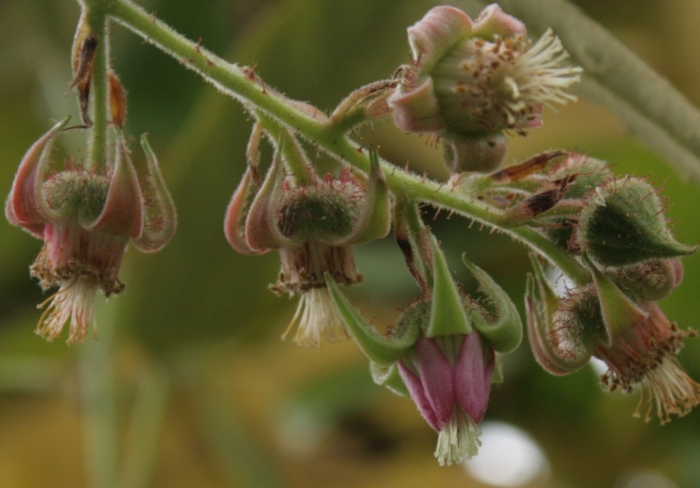Henry’s Raspberry
(Rubus henryi)
Henry’s Raspberry (Rubus henryi)
/
/

Sten Porse
CC BY-SA 3.0
Image By:
Sten Porse
Recorded By:
Copyright:
CC BY-SA 3.0
Copyright Notice:
Photo by: Sten Porse | License Type: CC BY-SA 3.0 | License URL: https://creativecommons.org/licenses/by-sa/3.0 | Uploader: Sten | Publisher: Wikipedia Commons









Estimated Native Range
Summary
Rubus henryi, commonly known as Henry’s Raspberry, is an evergreen perennial vine native to the mountainous regions and forest margins of Southeastern China. It can grow to a height of 15-18 feet (4.5-5.5 meters) and a width of up to 9 feet (2.7 meters). This species is characterized by its arching stems and dark green, pinnate leaves. During the summer months, it produces clusters of small, showy flowers that are pink to red, followed by edible, but not particularly tasty, red raspberries.
Henry’s Raspberry is valued for its ornamental foliage and flowers, as well as its ability to cover structures quickly, making it suitable for trellises, arbors, and fences. It is also used for erosion control on slopes. In cultivation, it prefers full sun to partial shade and requires medium amounts of water. It thrives in a variety of soil types, provided they have good drainage. While generally low-maintenance, it can be susceptible to common raspberry pests and diseases, such as raspberry cane borer and fungal infections. Pruning is necessary to maintain its shape and promote healthy growth.CC BY-SA 4.0
Henry’s Raspberry is valued for its ornamental foliage and flowers, as well as its ability to cover structures quickly, making it suitable for trellises, arbors, and fences. It is also used for erosion control on slopes. In cultivation, it prefers full sun to partial shade and requires medium amounts of water. It thrives in a variety of soil types, provided they have good drainage. While generally low-maintenance, it can be susceptible to common raspberry pests and diseases, such as raspberry cane borer and fungal infections. Pruning is necessary to maintain its shape and promote healthy growth.CC BY-SA 4.0
Plant Description
- Plant Type: Vine
- Height: 15-18 feet
- Width: 8-9 feet
- Growth Rate: Rapid
- Flower Color: Pink, Red
- Flowering Season: Summer
- Leaf Retention: Evergreen
Growth Requirements
- Sun: Full Sun, Part Shade
- Water: Medium
- Drainage: Slow, Medium, Fast
Common Uses
Bee Garden, Bird Garden, Butterfly Garden, Edible*Disclaimer: Easyscape's listed plant edibility is for informational use. Always verify the safety and proper identification of any plant before consumption., Groundcover, Hummingbird Garden
Natural Habitat
Mountainous regions and forest margins of Southeastern China
Other Names
Common Names: Ronce De Henry, Ji Zhao Cha
Scientific Names: , Rubus henryi, Rubus henryi var. henryi,
GBIF Accepted Name: Rubus henryi Hemsl. & Kuntze